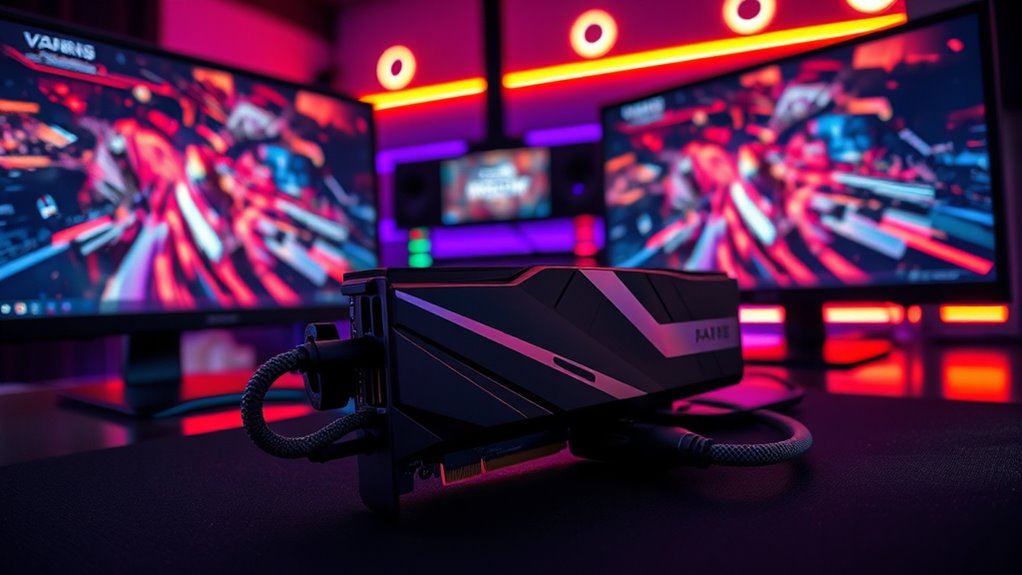If you’re aiming for smooth game streaming in 2025, I recommend checking out capture cards like Elgato’s 4K Pro and Cam Link 4K, which offer high-quality 4K recording and easy setup. For budget-friendly options, there are reliable USB models like Guermok and HD60 S. I’ll guide you through the top options that combine performance, portability, and compatibility so you can find the perfect fit for your streaming needs. Keep exploring to find out more.
Key Takeaways
- Prioritize capture cards supporting 1080p60 and 4K30/60 for high-quality, smooth gameplay streaming.
- Choose models with low latency HDMI pass-through and multi-view modes for versatile monitoring.
- Opt for portable, plug-and-play devices compatible with major OS and streaming software for easy setup.
- Consider high-end options offering 8K passthrough and HDR support for professional content creation.
- Balance features with budget, noting that premium devices provide advanced capabilities, while budget options suit casual streaming.
1080P@60fps Capture Card with LCD and Remote for PS4, Xbox, TV, DVR
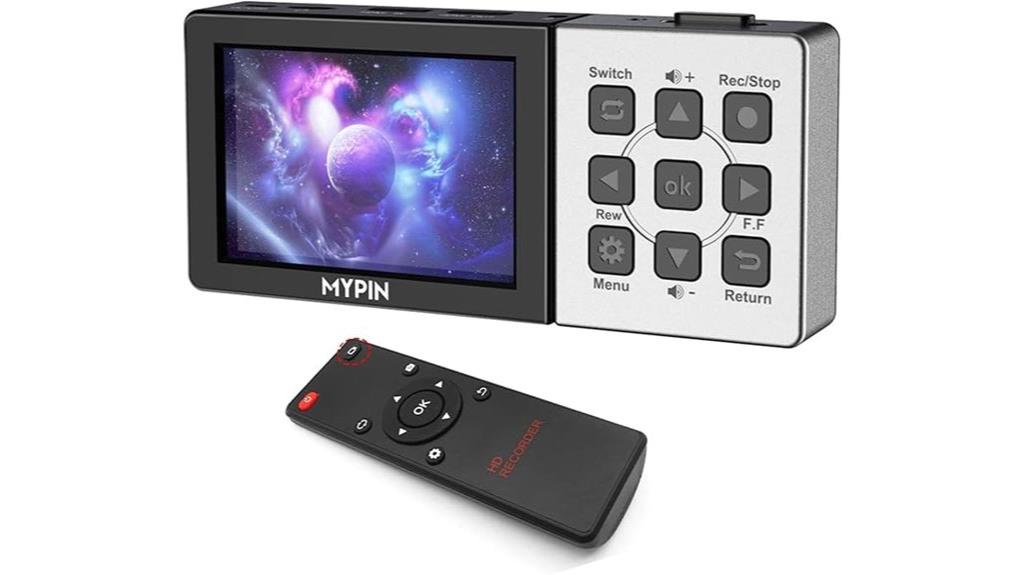
If you’re looking for a versatile and portable solution to capture gameplay or TV content, the 0P@60fps Capture Card with LCD and Remote is an excellent choice. It records Full HD 1080p videos at 60fps from consoles like PS4 and Xbox, as well as TV, DVR, and other sources. The built-in 3.5-inch LCD screen lets me preview footage in real-time, while the remote makes starting recordings quick and easy. With support for MP4 files, schedule recording, and a 3000mAh battery for portable use, it’s perfect for capturing on the go. Plus, I can add live commentary through the microphone jack, making it a all-encompassing streaming tool.
Best For: gamers, streamers, and content creators seeking a portable, easy-to-use device for high-quality video recording and live preview without needing a PC.
Pros:
- Records full HD 1080P videos at 60fps with real-time preview on a 3.5-inch LCD screen
- Supports schedule recording and MP4 file saving onto TF cards up to 128GB
- Portable design with built-in 3000mAh battery for up to 3 hours of use, plus remote control for convenient operation
Cons:
- Limited to HDMI sources; may not support other input types
- Battery life of approximately 3 hours might be insufficient for longer recording sessions
- Requires TF cards for storage, which may need to be purchased separately
Game Capture Card, HDMI PCIe 4K 30fps Record & Stream

The Game Capture Card with HDMI PCIe 4K 30fps support is an excellent choice for serious streamers and content creators who demand high-quality, smooth footage. It captures 4K resolution at 30FPS, ensuring crisp visuals and clear audio from various HDMI devices like gaming consoles, cameras, and media players. Its compatibility with Windows, Mac, and multiple PCIe slots makes installation straightforward with a low-profile bracket included. The card offers zero-latency HDMI loop-out, enabling latency-free viewing, while the PCIe interface delivers fast data transfer up to 500MB/s. Plus, it’s plug-and-play, so setup is quick and seamless for streaming, recording, or sharing content effortlessly.
Best For: serious gamers, professional streamers, and content creators seeking high-quality, smooth 4K recording and streaming capabilities.
Pros:
- Supports 4K @30FPS HDMI capture for crisp visuals and clear audio.
- Zero delay HDMI loop-out ensures latency-free viewing during live streams.
- Compatible with multiple operating systems and PCIe slots, offering versatile installation options.
Cons:
- Requires a PCIe slot, which may not be available in all computers.
- No built-in hardware encoder, relying on compatible software for streaming.
- May need additional power or accessories depending on system configuration.
4K HDMI Capture Card for Streaming and Gaming
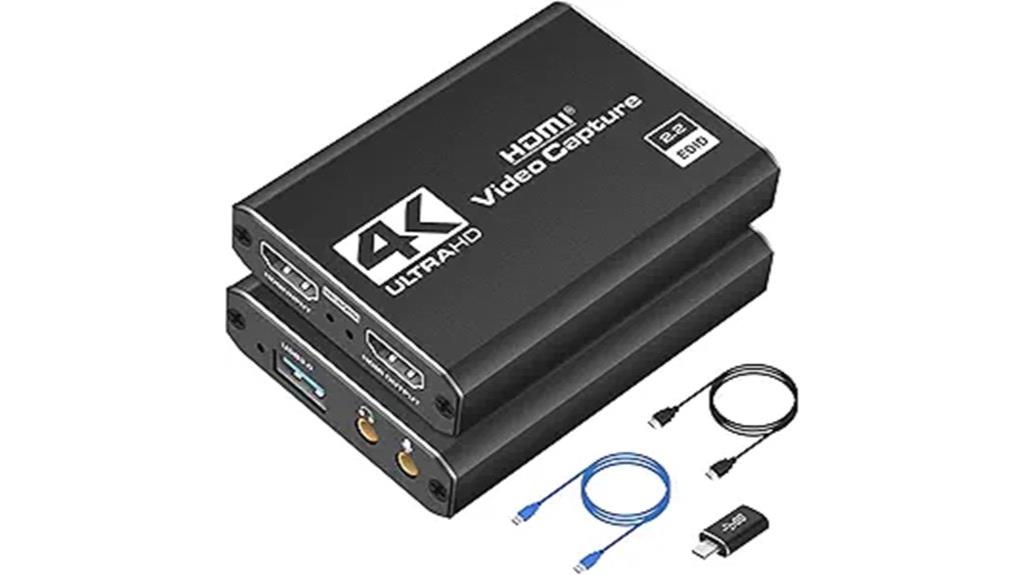
Are you looking for a reliable capture card that delivers stunning 4K quality without lag? The K HDMI Capture Card supports up to 4K 60fps input and Full HD 1080p 60fps recording, making it perfect for streaming, gaming, and live broadcasting. It’s compatible with Windows, Mac, and popular devices like PS5, Switch, Xbox, and DSLR cameras. The plug-and-play design requires no drivers or external power, and it captures audio and video simultaneously. Its sleek, compact form makes setup straightforward for beginners and pros alike. Users praise its crisp visuals, zero delay, and reliable performance—though some report occasional compatibility issues.
Best For: content creators, gamers, and streamers seeking high-quality 4K video capture with zero lag and easy setup.
Pros:
- Supports 4K 60fps input and Full HD 1080p 60fps recording for crisp visuals
- Plug-and-play design requiring no drivers or external power
- Compatible with multiple devices including Windows, Mac, PS5, Switch, Xbox, and cameras
Cons:
- Some users experience compatibility issues with certain devices like Nintendo Switch 2
- Occasional reports of hardware defects or color bar screens
- Limited warranty and potential variability in hardware quality
Capture Card for Nintendo Switch and Consoles (4K HDMI to USB 3.0)

A 4K HDMI to USB 3.0 capture card tailored for Nintendo Switch and other gaming consoles stands out as an excellent choice for streamers who want high-quality, low-latency gameplay capture. It supports 1080p at 60FPS and offers 4K pass-through, ensuring smooth gameplay without noticeable lag. Compatible with Windows and Mac, it’s plug-and-play, requiring no drivers or external power. The HDMI loop-out allows real-time gaming, while microphone input enables commentary. Compact and lightweight, it’s easy to set up and reliable for streaming, recording, or broadcasting. Overall, it delivers sharp visuals and seamless performance at an affordable price, making it a top pick for console gamers.
Best For: casual and professional gamers, streamers, and content creators seeking an affordable, easy-to-use HDMI capture solution for high-quality 1080p streaming and recording.
Pros:
- Plug-and-play setup with no drivers or external power required.
- Supports 1080p 60FPS for smooth, high-quality video capture.
- HDMI pass-through and loop-out enable real-time gaming without delay.
Cons:
- Limited to 1080p recording; does not support 4K recording.
- No USB-C or higher HDMI pass-through capabilities.
- Analog microphone and headphone jacks may require additional adapters for some devices.
AVerMedia 4K HDMI Capture Card for Streaming and Recording

If you’re serious about high-quality streaming and gaming, the AVerMedia GC553Pro stands out because it supports 4K60 HDR pass-through with ultra-low latency, allowing real-time gameplay monitoring without lag. It’s compatible with major consoles like PS5, Xbox Series X/S, Nintendo Switch, and PCs, offering plug-and-play setup with no extra drivers needed. It captures uncompressed video with vivid RGB colors and handles up to 240FPS recording in 1080p, perfect for fast-paced games. Its low latency—just 35ms—makes live streaming smooth and responsive. While some users report minor issues, overall, it’s a reliable choice for professional-level gameplay and content creation.
Best For: streamers, gamers, and content creators seeking high-quality 4K60 HDR pass-through with low latency for professional-level live gameplay and recording.
Pros:
- Supports 4K60 HDR and VRR pass-through for smooth, high-quality gameplay
- Ultra-low latency of just 35ms ideal for real-time streaming and monitoring
- Plug-and-play setup compatible with Windows, Mac, and iPadOS without extra drivers
Cons:
- Some users experience signal drops requiring refreshes during use
- Image quality may be limited with certain consoles like PS5 Pro, suggesting external solutions might be needed
- Occasional issues with software compatibility or customer support reported by a few users
Elgato HD60 S+ External Capture Card for PS5, PS4, Xbox Series X/S, PC & Mac

The Elgato HD60 S+ External Capture Card stands out as an ideal choice for serious streamers and gamers who demand high-quality visuals without lag. It supports 4K60 HDR10 passthrough for seamless gameplay on consoles like PS5, Xbox Series X/S, and PS4 Pro, while capturing in 1080p60 HDR10. Its compatibility with Windows and macOS, along with popular streaming software like OBS, offers great flexibility. The device’s low latency ensures real-time response, perfect for competitive gaming. Designed for ease of use, it’s portable and durable, making it suitable for both home setups and on-the-go streaming, delivering professional-quality recordings effortlessly.
Best For: serious streamers and gamers seeking high-quality, lag-free gameplay recording and streaming across multiple gaming platforms and computers.
Pros:
- Supports 4K60 HDR10 passthrough for seamless gameplay on next-gen consoles
- Captures in 1080p60 HDR10 with excellent visual fidelity
- Compatible with Windows and macOS, working smoothly with popular streaming software like OBS
Cons:
- Some users experience crashes or audio-video desynchronization on macOS
- Premium price reflects its advanced features, which may be a consideration for budget-conscious users
- Setup can be slightly complex due to port placement and software configurations
RGBlink Video Capture Card for Streaming in 1080P
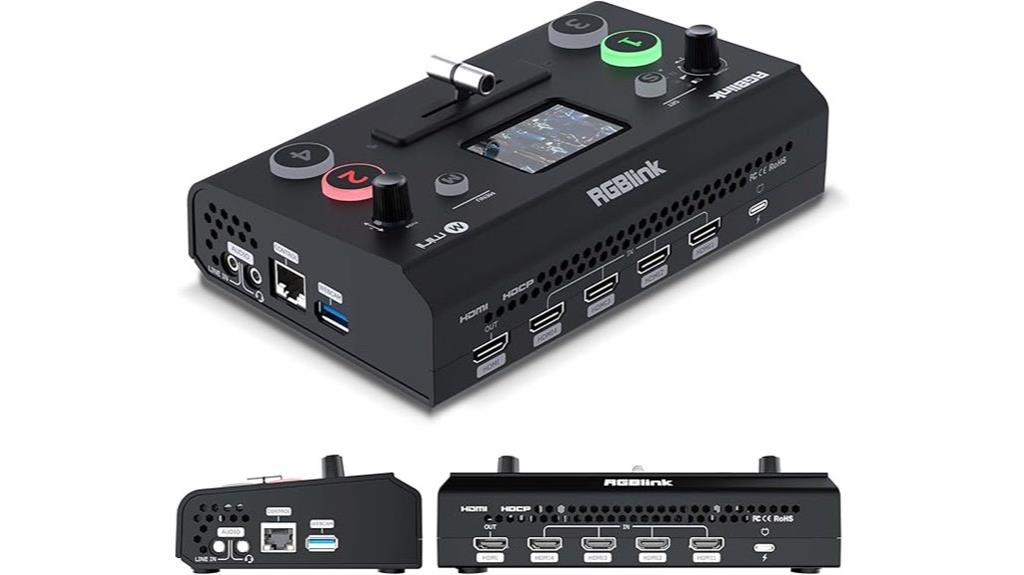
For content creators and streamers seeking high-quality visuals without breaking the bank, the RGBlink Video Capture Card for Streaming in 1080P offers an excellent solution. It delivers Full HD 1080P resolution with vivid clarity, supporting ultra-low latency streaming for real-time interaction. The device is compatible with platforms like OBS, Zoom, and vMix, and converts four HDMI inputs to USB, making it versatile for gaming consoles such as PS5, Xbox Series, and more. Its compact, portable design and easy plug-and-play setup make it ideal for both on-the-go streaming and home broadcasts. Overall, it’s a reliable, budget-friendly choice for serious streamers aiming for professional-quality content.
Best For: content creators and streamers seeking high-quality, budget-friendly 1080P streaming solutions with versatile device compatibility and easy setup.
Pros:
- Delivers crisp Full HD 1080P resolution with vivid clarity
- Supports ultra-low latency streaming for real-time interaction
- Compact, portable design ideal for on-the-go or home use
Cons:
- May require high-performance PC hardware for optimal operation
- Some users experience setup challenges and software compatibility issues
- Can run warm during extended use, necessitating proper cooling or system adjustments
4K HDMI Capture Card for Streaming and Gaming
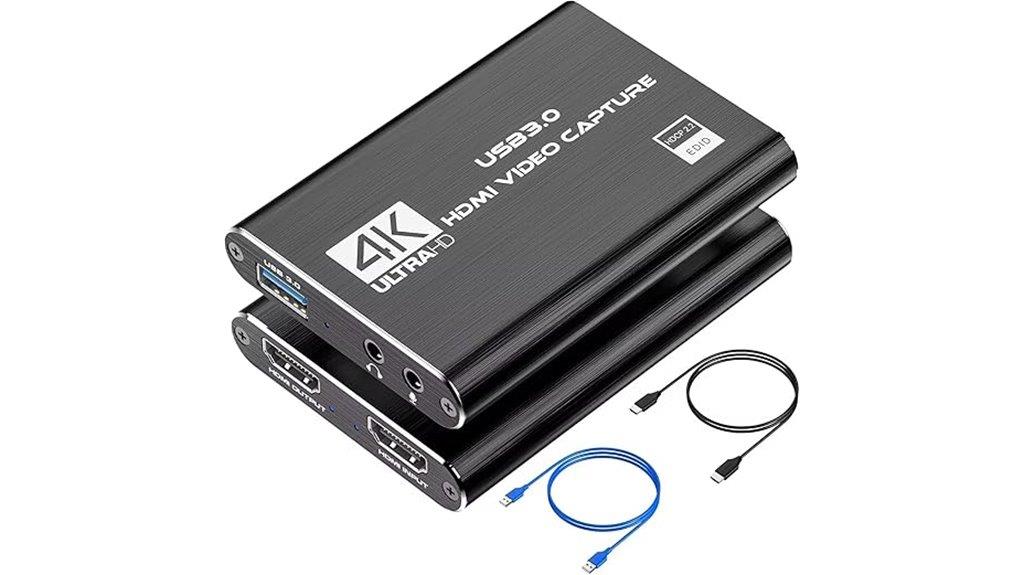
Looking for an affordable and straightforward way to stream gameplay or capture video from your devices? The K HDMI Capture Card is a solid choice. It supports Full HD 1080P at 60FPS via USB 3.0 and works with consoles like PS4, Xbox, and Nintendo Switch, as well as cameras and PCs. Its plug-and-play design makes setup easy, with no drivers needed. The HDMI loop-out ensures no delay during gameplay, and microphone input lets you add commentary. While it doesn’t support 4K HDR signals, it offers low latency and reliable performance for casual streaming and recording, all at an affordable price around $20.
Best For: casual streamers, hobbyists, and budget-conscious users looking for easy, reliable video capture from gaming consoles, cameras, or security devices.
Pros:
- Affordable price point around $20, offering good value for entry-level streaming.
- Plug-and-play setup requiring no drivers, making it easy for beginners.
- Supports 1080p 60FPS with low latency, suitable for smooth live streaming and recording.
Cons:
- Does not support 4K HDR signals, limiting high-end video quality options.
- Some users report overheating during extended use, which may affect long-term durability.
- Mixed reviews on durability, with occasional failures after limited use or prolonged operation.
EVGA XR1 Pro Capture Card (144-U1-CB21-LR)
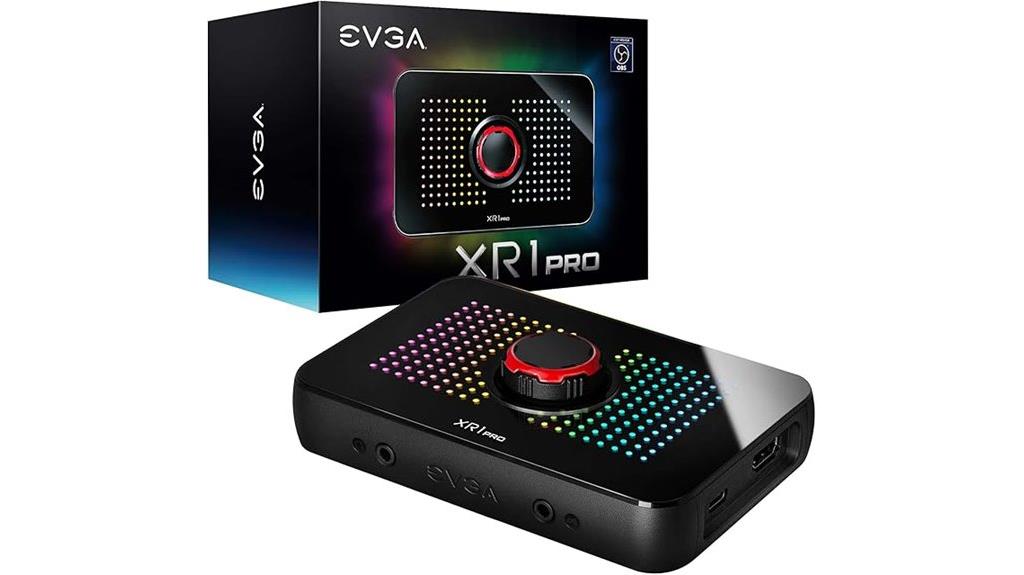
Are you seeking a capture card that offers effortless setup and reliable performance for casual streaming? The EVGA XR1 Pro is a solid choice, supporting 1440p at 60fps and 4K at 30fps, with true 144Hz HDR pass-through. It features customizable ARGB lighting, built-in audio controls, and a handy control dial for quick adjustments. Designed for plug-and-play use on Windows, it’s compatible with multiple consoles like PS5, Xbox Series X/S, and Nintendo Switch. While some users face HDMI compatibility issues and delays, its high-quality video, easy operation, and value for money make it ideal for casual streamers seeking straightforward performance.
Best For: casual streamers and gamers seeking an easy-to-use, plug-and-play capture card with reliable performance and high-quality video output.
Pros:
- Supports 1440p at 60fps and 4K at 30fps with HDR pass-through for high-quality visuals
- Easy setup with plug-and-play compatibility on Windows, no driver installation needed
- Features customizable ARGB lighting, built-in audio controls, and a convenient control dial
Cons:
- Compatibility issues with HDMI input, especially on Linux and some Windows configurations
- Occasional delays or audio-video sync problems that may require troubleshooting
- Limited Linux support and potential issues with HDCP protection on certain devices
Elgato HD60 S External Capture Card for Streaming and Recording
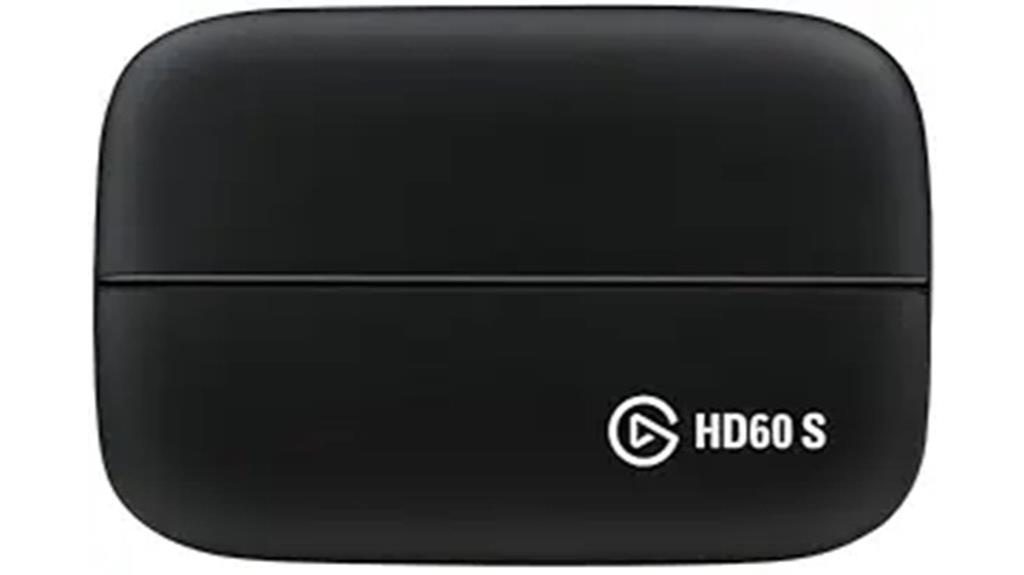
The Elgato HD60 S stands out as an ideal choice for streamers seeking high-quality gameplay capture with minimal latency. This compact device delivers 1080p60 recording and true pass-through with zero lag, making it perfect for live streaming and recording from consoles like PS5, Xbox Series X/S, or PC. Its USB 3.0 connection guarantees smooth performance, and setup is straightforward with Elgato’s user-friendly software. Compatible with Windows and Mac, it integrates seamlessly with platforms like OBS, Twitch, and YouTube. Its reliable build, instant detection, and high-quality output make it a top pick for both casual and professional streamers.
Best For: streamers and gamers seeking high-quality, low-latency gameplay recording and streaming from various consoles and PCs.
Pros:
- Easy to set up with user-friendly software and seamless integration with OBS, Twitch, and YouTube
- Compact, portable design with durable build quality
- Supports 1080p60 recording with true pass-through and zero lag for live gameplay
Cons:
- Occasional loose USB connections that may require cable replacement
- Frequent software and firmware updates necessary for optimal performance
- Default color calibration may need adjustment for accurate video output
Elgato Game Capture Neo USB 4K60 HDR Capture Card
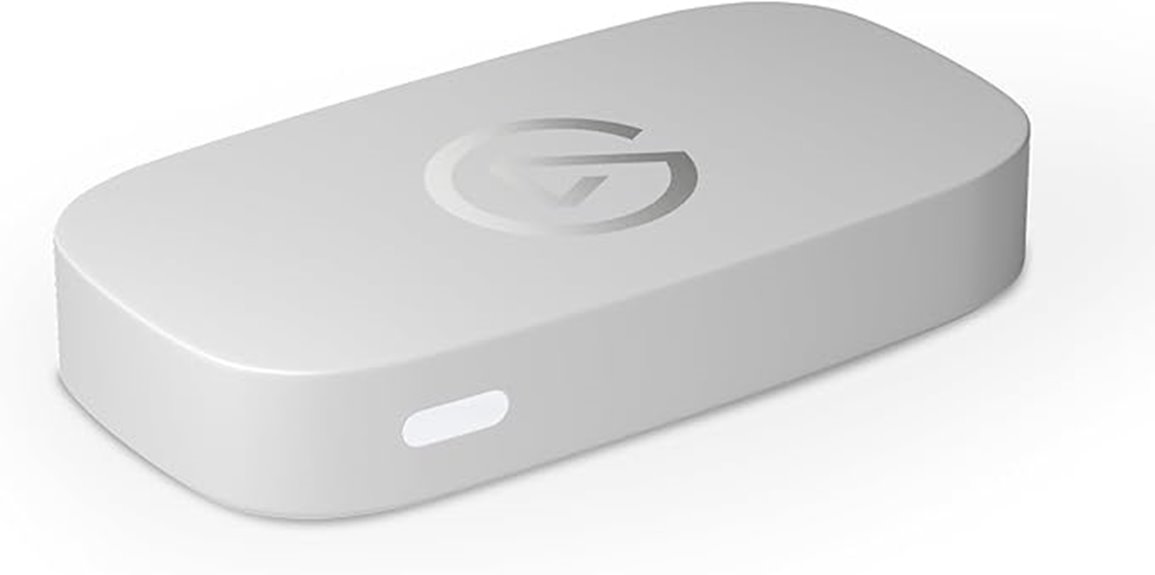
If you want a compact, high-performance capture card that supports 4K HDR passthrough while streaming in Full HD, the Elgato Game Capture Neo USB 4K60 HDR is an excellent choice. Its small size makes it portable, and it easily connects to consoles, PCs, Macs, or iPads via USB-C. It allows you to play in 4K HDR without quality loss while capturing or streaming at 1080p60. With lag-free passthrough and broad compatibility with software like OBS and QuickTime, it’s perfect for high-quality gameplay recording. Keep in mind, it doesn’t include HDMI cables and requires a USB 3.0 port, but setup is generally straightforward.
Best For: gamers, streamers, and content creators seeking a compact, high-quality capture card with 4K HDR passthrough and Full HD streaming capabilities.
Pros:
- Supports 4K60 HDR passthrough for high-quality gameplay without lag or quality loss
- Compact and portable design, easy to connect to various devices via USB-C
- Compatible with popular streaming and recording software like OBS, QuickTime, and more
Cons:
- Does not include HDMI cables, requiring users to supply their own
- Limited to 1080p60 recording, cannot capture above this resolution
- Setup can be complex in certain configurations, especially with additional devices or audio setups
MYPIN USB3.0 HDMI Video Capture Card for Gaming and Streaming
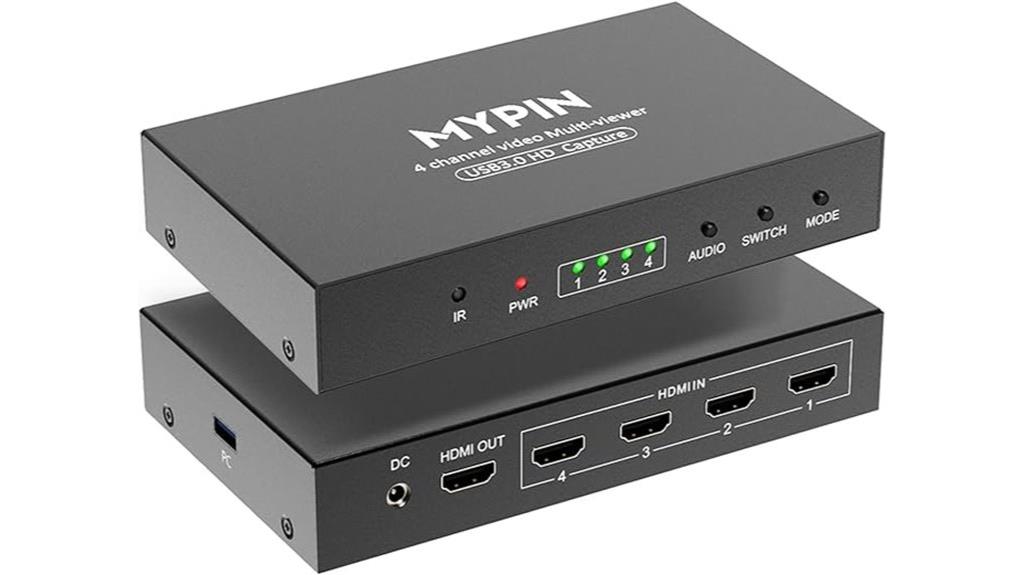
For streamers and gamers seeking a reliable, plug-and-play solution, the MYPIN USB3.0 HDMI Video Capture Card offers impressive versatility with support for four HDMI channels and 1080P@60fps recording. Compatible with a wide range of devices like consoles, cameras, and set-top boxes, it features HDMI loop-out for real-time display. Its multi-view modes—including PIP, quad, and dual views—make multi-source monitoring easy. With no need for external drivers, it’s simple to set up and works seamlessly with OBS, VLC, and more. While it doesn’t support 4K, its stability and multi-channel capabilities make it ideal for multi-camera streaming and monitoring.
Best For: streamers, gamers, and multi-camera monitoring setups seeking a reliable, plug-and-play 1080P@60fps capture solution with multi-view options.
Pros:
- Supports four HDMI channels with multi-view modes like PIP, quad, and dual views for versatile monitoring.
- Plug-and-play operation with no external drivers required, compatible with Windows, Mac, Linux, and popular streaming software.
- Robust metal build with real-time HDMI loop-out, ensuring low-latency streaming and stable performance.
Cons:
- No 4K support, limiting resolution for high-end professional or future-proof needs.
- Resolution can decrease significantly when displaying multiple sources simultaneously, affecting image quality.
- Overlay text cannot be disabled, which may be distracting during streams or recordings.
Guermok 4K USB3.0 HDMI Capture Card for Streaming (Silver)
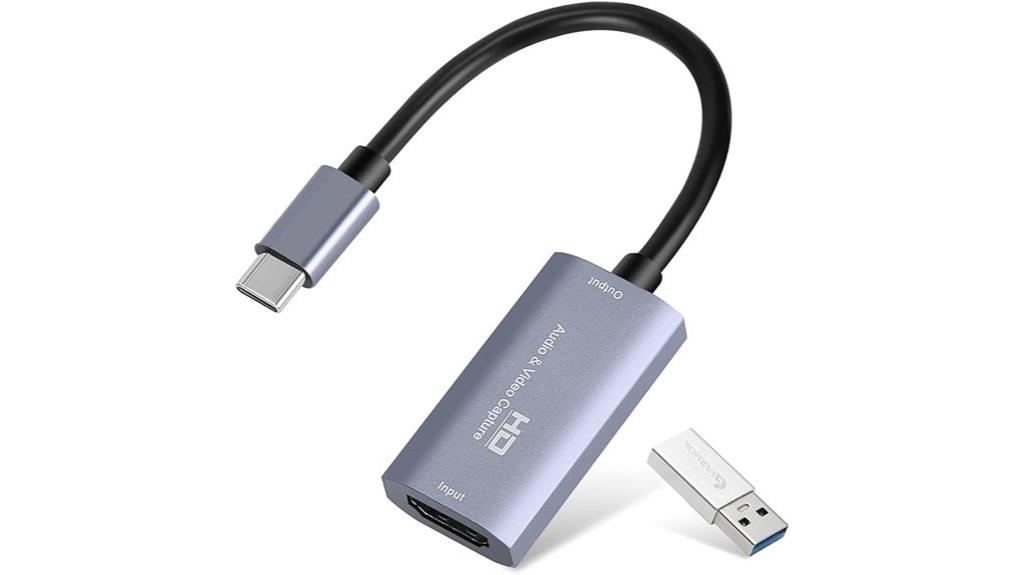
Anyone looking for high-quality, real-time streaming with minimal latency should consider the Guermok 4K USB3.0 HDMI Capture Card. It supports 1080P 60FPS recording and input resolutions up to 4K@30Hz, making it ideal for smooth gameplay and professional content. Compatible with Windows, Mac, Linux, Android, and various devices like PS5, Switch, and cameras, it offers plug-and-play operation with USB 3.0 high-speed transfer. Its compact aluminum design guarantees heat dissipation, while support for multiple streaming platforms ensures versatility. Easy to set up and use, it’s a dependable choice for streamers, gamers, and content creators seeking clear visuals and audio with low latency.
Best For: content creators, streamers, and gamers seeking high-quality, low-latency live streaming and recording with versatile device compatibility.
Pros:
- Supports 1080P 60FPS recording and 4K@30Hz input for smooth, professional-quality video
- Plug-and-play setup with USB 3.0 high-speed transmission for easy use without drivers
- Compatible with a wide range of devices and platforms including Windows, Mac, Linux, Android, PS5, Switch, and cameras
Cons:
- Occasional recognition issues may require device flipping or software restart
- No external power supply needed, which might limit some advanced configurations
- Slightly limited output resolution options beyond 2K@30Hz and 1080P@60Hz
Elgato 4K Pro Internal Capture Card for PS5, Xbox Series S & Switch
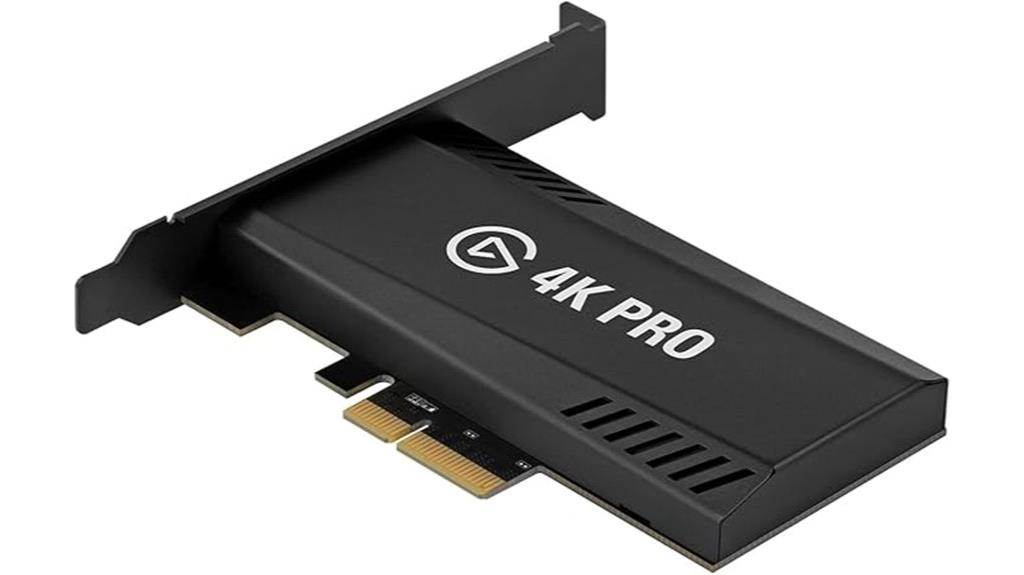
The Elgato 4K Pro Internal Capture Card stands out as an excellent choice for serious streamers and gamers who demand top-tier quality and high performance. It supports 8K60 passthrough and 4K60 HDR10 recording, making it perfect for PS5, Xbox Series S/X, and Switch. With HDMI 2.1, VRR passthrough, and ultra-low latency, it delivers smooth, high-quality gameplay and capture. Compatible with popular streaming apps like OBS and Streamlabs, it offers customizable settings and local recording. Installing it requires a PCIe slot, but once set up, it provides reliable, high-fidelity video and audio, ensuring your streams look professional and flawless.
Best For: serious streamers and gamers seeking high-quality, high-performance capture and passthrough for next-gen consoles and devices.
Pros:
- Supports 8K60 passthrough and 4K60 HDR10 recording for ultra-high-resolution streaming.
- Features HDMI 2.1, VRR passthrough, and ultra-low latency for smooth gameplay and capture.
- Compatible with popular streaming platforms and apps, with customizable video and audio settings.
Cons:
- Requires a PCIe x4, x8, or x16 slot, limiting compatibility with some PC configurations.
- Occasional issues with software re-encoding delays and signal loss reported by users.
- Installation can be challenging in PCs with multiple high-end components due to space constraints.
Elgato Cam Link 4K External Capture Card
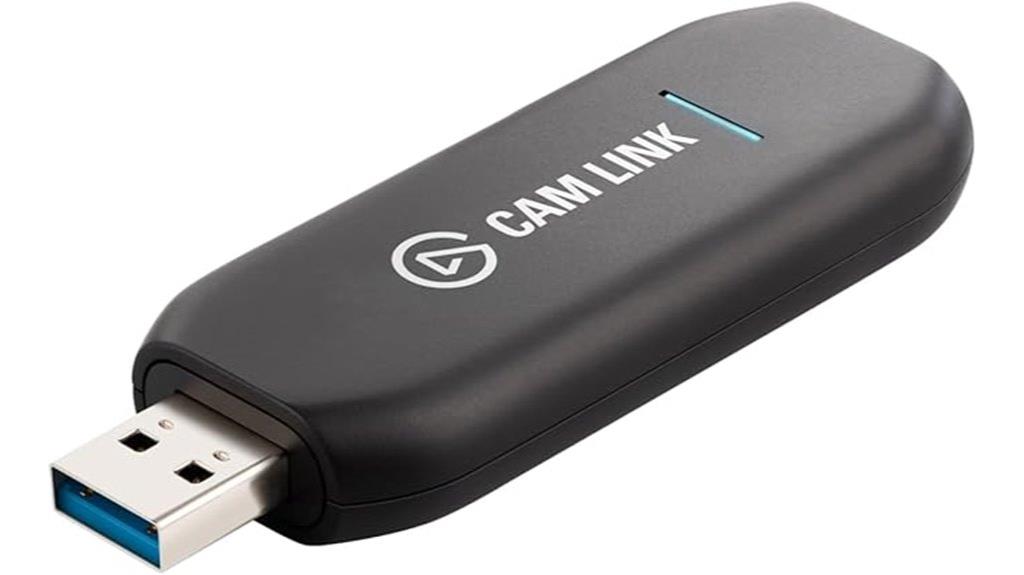
The Elgato Cam Link 4K stands out as an ideal choice for serious streamers and content creators who demand professional-quality video. It transforms high-end DSLR, mirrorless cameras, camcorders, action cams, and smartphones into webcams that deliver stunning visuals. Compatible with Windows, macOS, iPadOS, and USB 3.x ports, it supports resolutions up to 4K60 (MJPG only) and 1080p60. The device is compact, lightweight, and easy to set up—plug and play with no drivers needed. Stream in crisp 1080p60 or 4K30, with minimal latency, making it perfect for streaming, videoconferencing, or digitizing memories. Its reliability and high-quality output make it a top-tier choice.
Best For: streamers, content creators, and professionals seeking high-quality, reliable video capture from cameras and smartphones for streaming, recording, or videoconferencing.
Pros:
- Delivers professional-quality 4K and 1080p video with minimal latency
- Plug-and-play setup with no drivers needed, compatible across multiple operating systems
- Compact, lightweight design ideal for portable use and easy integration into setups
Cons:
- 4K60 support limited to MJPG format, which may reduce flexibility for some workflows
- Generates heat during extended use, potentially requiring additional cooling considerations
- Higher price point compared to basic capture devices, reflecting its premium quality
Factors to Consider When Choosing Capture Cards for Streaming
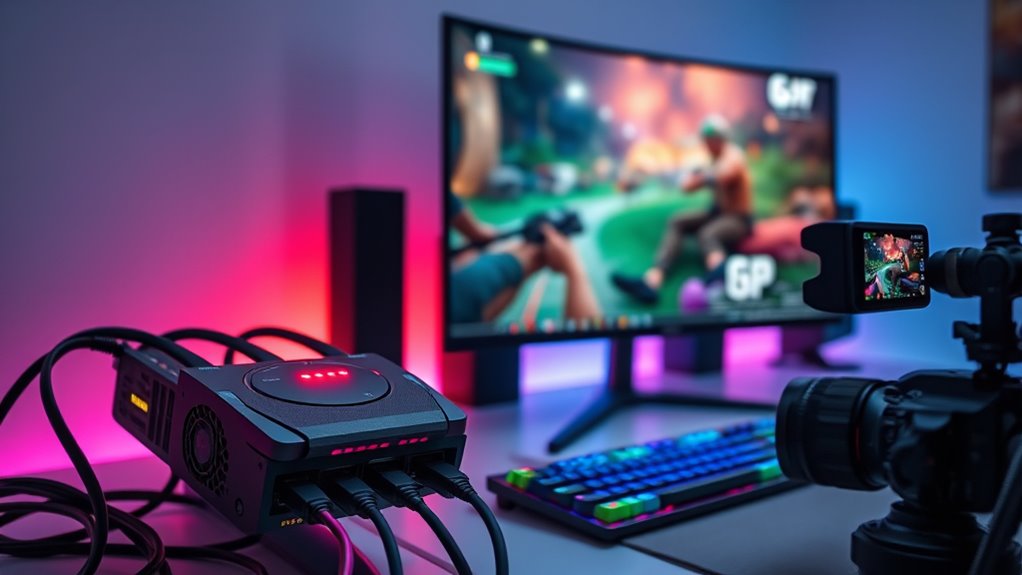
When choosing a capture card, I look at resolution and frame rate to guarantee smooth gameplay and high-quality footage. Compatibility with my devices and connection options are also essential to avoid setup headaches. Additionally, I consider latency, software support, and how well the card integrates into my streaming workflow.
Resolution and Frame Rate
Choosing the right capture card for streaming depends heavily on resolution and frame rate, as these factors directly impact image quality and gameplay fluidity. Higher resolution capture cards support 4K or higher, offering sharper images for viewers and better recording quality. Frame rate, such as 60fps or 120fps, determines how smoothly motion appears; higher fps delivers more fluid gameplay visuals. Most consumer-grade capture cards support 1080p at 60fps, providing a good balance between quality and system performance. For fast-paced games, at least 60fps is essential to accurately capture in-game motion without blurring. Some advanced cards handle 4K at 30 or 60fps, but higher frame rates like 120fps are usually limited to lower resolutions, making it important to match your needs with the card’s capabilities.
Compatibility With Devices
Selecting a capture card that works seamlessly with your devices is essential to a smooth streaming setup. First, verify it supports the input and output connections your devices use, like HDMI, USB, or PCIe ports. Compatibility with your operating system—Windows, macOS, Linux, or mobile platforms—is vital for hassle-free use. Also, check if the capture card can handle your source device’s resolution and frame rate, such as 1080p60 or 4K60, to avoid performance issues. If you’re gaming on a console like PS5, Xbox Series X, or Switch, confirm the capture card’s compatibility. Finally, review its support for your preferred streaming software, whether it’s OBS, Streamlabs, or proprietary solutions, to guarantee smooth integration and recording.
Connection Types Needed
To guarantee your streaming setup runs smoothly, it’s essential that your capture card supports the connection types compatible with your devices. For high-quality sources like gaming consoles, HDMI is the standard, supporting 1080p, 4K, and HDR signals depending on your device. If you’re using an external capture card, USB 3.0 or higher is vital for handling the high data transfer rates needed for smooth 1080p60 or 4K streaming without lag. Internal PCIe capture cards require an available PCIe slot in your PC and typically connect via HDMI input or output. Always verify that the capture card’s connection type matches your hardware setup and streaming platform to guarantee seamless data flow and top performance during your streams.
Latency and Delay
When it comes to streaming, low latency is essential for ensuring your gameplay remains synchronized with your broadcast. A good capture card should have a delay of less than 30 milliseconds, so your gameplay stays in sync with what viewers see. HDMI loop-out and pass-through features are vital because they let you monitor your game without adding extra lag. Faster interfaces like USB 3.0 and PCIe provide higher data transfer rates, reducing delay compared to USB 2.0. Higher latency can cause noticeable lag between your game and stream, which affects both gameplay responsiveness and viewer experience. To minimize delay, proper setup is crucial—disable unnecessary processing features and tweak software settings to achieve the lowest possible latency for seamless streaming.
Software Compatibility
Have you checked if your chosen capture card works seamlessly with your preferred streaming software? Compatibility is vital for a smooth streaming experience. Make sure the device supports popular platforms like OBS, Streamlabs, or XSplit. Also, verify that it works with your operating system—Windows, macOS, Linux, or iOS—to avoid technical hiccups. Regular driver and software updates from the manufacturer are a good sign; they help maintain stability and fix bugs. Additionally, confirm the capture card can handle your desired resolution and frame rate, whether 1080p60 or 4K60 HDR. Features like plug-and-play setup, customizable settings, and easy configuration can streamline your workflow. Prioritizing software compatibility ensures your streaming process remains stable, efficient, and hassle-free.
Portability and Size
Choosing a capture card isn’t just about compatibility and performance; portability and size also play a big role, especially if you’re streaming on the go. Smaller capture cards are highly portable, making them perfect for mobile content creation or remote streaming. They typically weigh less than a pound, so carrying them around is effortless, and they take up minimal desk space. Most portable options connect via USB or external cables, avoiding complicated internal installations. However, size can limit the number of input/output ports, so it’s essential to check if the device supports all your necessary connections. Lightweight and compact capture cards excel at live events, travel, and remote recording sessions, offering the mobility you need without sacrificing quality or ease of use.
Budget and Cost
Are you trying to find a capture card that fits your budget without sacrificing essential features? Capture cards vary widely in price, from budget options around $20 to professional-grade devices over $300. Cheaper models typically support 1080p60 streaming but may have limitations in build quality, durability, or software stability. Higher-end cards often provide support for higher resolutions, faster frame rates, and advanced features like HDR, VRR, or 4K60 HDR pass-through, offering better performance and future-proofing. When choosing, consider your system compatibility, streaming needs, and desired video quality. Sometimes, investing a bit more upfront can lead to better reliability and a smoother streaming experience in the long run. Balancing cost with features ensures you get the best value for your setup.
Frequently Asked Questions
How Do Capture Cards Impact Overall Gaming Performance?
When considering how capture cards impact gaming performance, I find that they generally don’t affect my gameplay directly. Instead, they handle streaming and recording tasks separately, so my game runs smoothly without lag or stutter. However, if my PC or console isn’t powerful enough, the additional load from streaming could cause some slowdown. Overall, a good capture card enhances my streaming experience without negatively impacting my game performance.
What Compatibility Issues Should I Watch For?
When choosing a capture card, I always check for compatibility issues like matching the card with my PC’s ports and ensuring my console or device supports it. I watch out for driver support and software updates too, since outdated drivers can cause crashes. HDMI versions matter, too—making sure my setup’s compatible prevents lag or resolution problems. Staying aware of these issues helps me stream smoothly without hiccups.
Are There Latency Differences Between Internal and External Cards?
Latency is like a race; every millisecond counts. When comparing internal and external capture cards, internal ones often have lower latency because they connect directly to your motherboard, minimizing delays. External cards, while convenient, might introduce slight lag due to USB transfer times. However, advancements in technology have narrowed this gap. Overall, if you’re aiming for the fastest response, internal cards usually edge out externally.
How Many Devices Can a Capture Card Support Simultaneously?
The number of devices a capture card can support at once really depends on the model. Most standard cards are designed for a single input, but some high-end or specialized models can handle multiple sources simultaneously. I recommend checking the specifications of each card to see how many inputs or streams it supports, because this varies widely. Generally, if you want to connect several devices at once, look for a card explicitly built for multi-input use.
What Is the Recommended Storage Setup for Captured Footage?
When it comes to storing captured footage, I recommend using a dedicated, high-capacity SSD or HDD. An SSD offers faster read/write speeds, which helps when editing or transferring files, while a large HDD provides ample storage for long gaming sessions. I usually keep my footage on an external drive, regularly backing it up to prevent data loss. Make sure your storage setup matches your recording quality and duration needs for seamless workflow.
Conclusion
Choosing the right capture card is like finding the perfect lens for your streaming journey—clear, reliable, and tailored to your needs. Whether you’re chasing 4K clarity or smooth 1080p gameplay, these top picks are your trusted companions on the road to seamless streaming. So, gear up, hit play, and let your content shine brighter than ever. With the right tool in hand, you’re ready to turn your gaming passion into a show-stopping performance.

